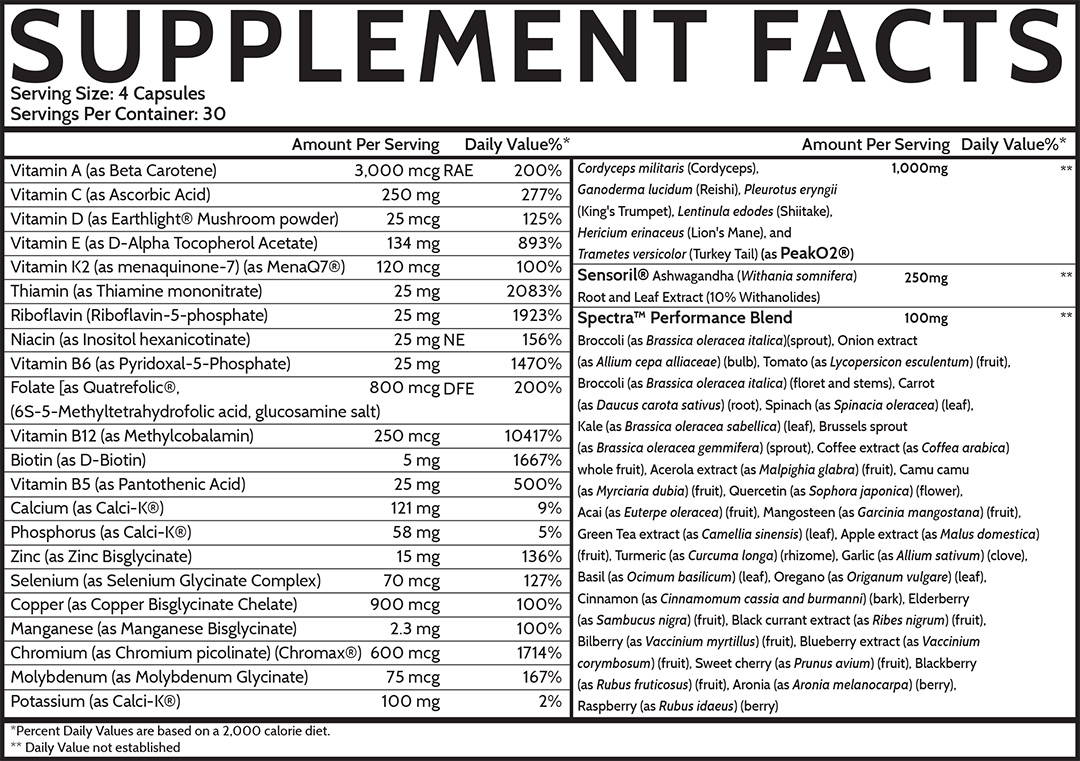Weydert, Joy. “Vitamin D in Children’s Health.” Children, vol. 1, no. 2, 12 Sept. 2014, pp. 208–226, 10.3390/children1020208; https://www.ncbi.nlm.nih.gov/pmc/articles/PMC4928729/
Sato, T. et al. Apr. 2020. “MK-7 and Its Effects on Bone Quality and Strength.” Nutrients vol. 12,4; 965. https://www.ncbi.nlm.nih.gov/pmc/articles/PMC7230802/
Maresz, K. et al. Feb. 2015. “Proper Calcium Use: Vitamin K2 as a Promoter of Bone and Cardiovascular Health.” Integrative Medicine vol. 14,2; 34-9. https://www.ncbi.nlm.nih.gov/pmc/articles/PMC4566462/
Kerr, D N. “Hypercalcemia and metastatic calcification.” Cardiovascular research vol. 36,3 (1997): 293-7. doi:10.1016/s0008-6363(97)00243-5; https://academic.oup.com/cardiovascres/article/36/3/293/298591
Godfrey, P.S.A, et al. “Enhancement of Recovery from Psychiatric Illness by Methylfolate.” The Lancet, vol. 336, no. 8712, Aug. 1990, pp. 392–395, 10.1016/0140-6736(90)91942-4; https://pubmed.ncbi.nlm.nih.gov/1974941/
Taylor, Matthew J, et al. “Folate for Depressive Disorders.” Cochrane Database of Systematic Reviews, 22 Apr. 2003, 10.1002/14651858.cd003390; https://www.ncbi.nlm.nih.gov/pmc/articles/PMC6991158/
Roberts, Emmert, et al. “Caveat Emptor: Folate in Unipolar Depressive Illness, a Systematic Review and Meta-Analysis.” Journal of Psychopharmacology, vol. 32, no. 4, 14 Feb. 2018, pp. 377–384, 10.1177/0269881118756060; https://pubmed.ncbi.nlm.nih.gov/29442609/
Miraglia, Niccolò, et al. “Enhanced Oral Bioavailability of a Novel Folate Salt: Comparison with Folic Acid and a Calcium Folate Salt in a Pharmacokinetic Study in Rats.” Minerva Ginecologica, vol. 68, no. 2, 1 Apr. 2016, pp. 99–105; https://pubmed.ncbi.nlm.nih.gov/27008238/ (full-text PDF)
Anderson RA et al; “Stability and Absorption of Chromium and Absorption of Chromium Histidinate Complexes by Humans”; Biol Trace Elem Res.; 2004 Dec;101(3):211-8. doi: 10.1385/BTER:101:3:211; https://pubmed.ncbi.nlm.nih.gov/15564651/
DiSilvestro RA and Dy, E. “Comparison of Acute Absorption of Commercially Available Chromium Supplements”; J Trace Elem Med Bio.; 2007;21(2):120-4. doi: 10.1016/j.jtemb.2007.01.004; https://pubmed.ncbi.nlm.nih.gov/17499152/
Vincent JB.; “Quest for the molecular mechanism of chromium action and its relationship to diabetes”; Nutr Rev; 2000; 58(3 Pt 1); 67‐72; https://pubmed.ncbi.nlm.nih.gov/10812920/
Vincent JB.; “Mechanisms of chromium action: low-molecular-weight chromium-binding substance”; J Am Coll Nutr; 1999; 18(1); 6‐12; https://pubmed.ncbi.nlm.nih.gov/10067653/
Yamamoto, A et al; “Evidence that chromium is an essential factor for biological activity of low-molecular-weight, chromium-binding substance”; Biochemical and biophysical research communications; vol. 163,1; 1989; 189-93.; https://pubmed.ncbi.nlm.nih.gov/2775259/
Davies S, McLaren Howard J, Hunnisett A, Howard M.; “Age-related decreases in chromium levels in 51,665 hair, sweat, and serum samples from 40,872 patients–implications for the prevention of cardiovascular disease and type II diabetes mellitus.”; Metabolism; 1997; 46(5); 469‐473; https://pubmed.ncbi.nlm.nih.gov/9160809/
Kaats, GR et al; “Effects of Chromium Picolinate Supplementation on Body Composition: A Randomized, Double-Masked, Placebo-Controlled Study”; Current Therapeutic Research; Vol. 57, No. 10, October 1996; https://www.sciencedirect.com/science/article/abs/pii/S0011393X96800804
Kaats, GR et al; “A randomized, double-masked, placebo-controlled study of the effects of chromium picolinate supplementation on body composition: A replication and extension of a previous study”; Current Therapeutic Research; 59(6); June 1998, pp. 379-388; https://www.sciencedirect.com/science/article/pii/S0011393X98850406
Tian H, Guo X, Wang X, et al; “Chromium picolinate supplementation for overweight or obese adults.”; Cochrane Database Syst Rev; (11):CD010063; 2013 Nov 29; https://pubmed.ncbi.nlm.nih.gov/24293292/
Onakpoya, I., et al. “Chromium Supplementation in Overweight and Obesity: A Systematic Review and Meta-Analysis of Randomized Clinical Trials.” Obesity Reviews, vol. 14, no. 6, 18 Mar. 2013, pp. 496–507, 10.1111/obr.12026; https://pubmed.ncbi.nlm.nih.gov/23495911/
Docherty, J et al; “A Double-Blind, Placebo-Controlled, Exploratory Trial of Chromium Picolinate in Atypical Depression: Effect on Carbohydrate Craving.”; Journal of Psychiatric Practice; September 2005; Volume 11, Issue 5; pp 302-314; https://journals.lww.com/practicalpsychiatry/Abstract/2005/09000/A_Double_Blind,_Placebo_Controlled,_Exploratory.4.aspx
Anton, Stephen D et al; “Effects of chromium picolinate on food intake and satiety.”; Diabetes technology & therapeutics; vol. 10,5; 2008; 405-12; https://pubmed.ncbi.nlm.nih.gov/18715218/
McLeod, M. N., et al. “Chromium Potentiation of Antidepressant Pharmacotherapy for Dysthymic Disorder in 5 Patients.” The Journal of Clinical Psychiatry, vol. 60, no. 4, 1 Apr. 1999, pp. 237–240, 10.4088/jcp.v60n0406; https://pubmed.ncbi.nlm.nih.gov/10221284/
McLeod, Malcolm N., and Robert N. Golden. “Chromium Treatment of Depression.” The International Journal of Neuropsychopharmacology, vol. 3, no. 4, Dec. 2000, pp. 311–314, 10.1017/s146114570000208x; https://academic.oup.com/ijnp/article/3/4/311/786852
Davidson, Jonathan R.T, et al. “Effectiveness of Chromium in Atypical Depression: A Placebo-Controlled Trial.” Biological Psychiatry, vol. 53, no. 3, Feb. 2003, pp. 261–264, 10.1016/s0006-3223(02)01500-7; https://www.sciencedirect.com/science/article/abs/pii/S0006322302015007
Hirsch, Katie R , et al; “Chronic Supplementation of a Mushroom Blend on Oxygen Kinetics, Peak Power, and Time to Exhaustion.”; Journal of the International Society of Sports Nutrition; BioMed Central; 21 Sept. 2015; https://jissn.biomedcentral.com/articles/10.1186/1550-2783-12-S1-P45
Wesley David Dudgeon, Dennison David Thomas, William Dauch, Timothy Paul Scheett, and Michael John Webster; “The Effects of High and Low-Dose Cordyceps Militaris-Containing Mushroom Blend Supplementation After Seven and Twenty-Eight Days”; American Journal of Sports Science; 2018; 6(1): 1-7; https://article.sportssciencejournal.org/pdf/10.11648.j.ajss.20180601.11.pdf
Lopresti, Adrian L et al. “An investigation into the stress-relieving and pharmacological actions of an ashwagandha (Withania somnifera) extract: A randomized, double-blind, placebo-controlled study.”; Medicine vol. 98,37 (2019): e17186; https://www.ncbi.nlm.nih.gov/pmc/articles/PMC6750292/
Chandrasekhar, K et al. “A prospective, randomized double-blind, placebo-controlled study of safety and efficacy of a high-concentration full-spectrum extract of ashwagandha root in reducing stress and anxiety in adults.” Indian journal of psychological medicine vol. 34,3 (2012): 255-62; https://www.ncbi.nlm.nih.gov/pmc/articles/PMC3573577/
Andrade C, Aswath A, Chaturvedi SK, et al. “A double-blind, placebo-controlled evaluation of the anxiolytic efficacy of an ethanolic extract of withania somnifera”; Indian J Psychiatry 2000;42:295–301; https://www.ncbi.nlm.nih.gov/pmc/articles/PMC2958355/
Auddy B, Hazra J, Mitra A, et al. A standardized Withania Somnifera extract significantly reduces stress-related parameters in chronically stressed humans: a double-blind, randomized, placebo-controlled study. J Am Nutraceut Assoc 2008;11:50–6; https://www.semanticscholar.org/paper/A-Standardized-Withania-Somnifera-Extract-Reduces-A-Auddy-Hazra/46bdaebfcf4f00730ad217fd6bb88228964e4c2e
Dressle, Raphael J et al. “HPA axis activity in patients with chronic insomnia: A systematic review and meta-analysis of case-control studies.” Sleep medicine reviews vol. 62 (2022): 101588. doi:10.1016/j.smrv.2022.101588; https://www.sciencedirect.com/science/article/abs/pii/S1087079222000016?via%3Dihub
Lee, Da-Hye et al. “Withania somnifera Extract Enhances Energy Expenditure via Improving Mitochondrial Function in Adipose Tissue and Skeletal Muscle.” Nutrients vol. 12,2 431. 7 Feb. 2020, doi:10.3390/nu12020431 https://www.ncbi.nlm.nih.gov/pmc/articles/pmid/32046183/
Nemzer BV, Fink N, Fink B; “New insights on effects of a dietary supplement on oxidative and nitrosative stress in humans”; Food Sci Nutr. 2014;2(6):828–839; https://www.ncbi.nlm.nih.gov/pmc/articles/PMC4256589/






